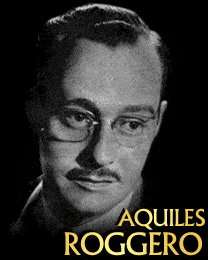Born on March 12, 1913, in Pehuajó, Argentina, Aquiles Roggero is remembered for playing piano, directing, and working with some of the most talented musicians of the 1940s and 1950s such as Osmar Maderna.
Career
Aquiles Roggero, the son of Luisa Guallini and José María Roggero, was no stranger to musical talent. His cousin, Virginia Vera, was a renowned singer, guitarist, composer, and actress.
He embarked on a musical journey that would etch his name in the annals of Argentine Tango history. Raised in a family with musical roots, Aquiles Roggero‘s connection to the art form seemed destined from the start. His early exposure to the rich tapestry of tango melodies laid the foundation for a career that would leave an indelible mark.
1930s: Joining the Rhythm: Vitaphone Orchestra
In the mid-1930s, Roggero’s talent as a pianist found its first spotlight as he joined the Vitaphone Orchestra. Under the direction of his fellow townsperson and friend, Osmar Maderna, Roggero’s nimble fingers danced across the keys, adding a vibrant rhythm to the orchestra’s compositions.
1940s: Musical Odyssey with “Los Rítmicos” and Osmar Maderna
The 1940s witnessed Roggero’s evolution as an integral part of the “Los Rítmicos” group. His musical prowess caught the attention of Osmar Maderna once again, leading to an invitation to join Maderna’s newly formed orchestra after he departed from Miguel Caló’s ensemble. This collaboration marked a significant chapter in Roggero’s tango career.
1950s: Orchestrating a Legacy: “Orquesta Símbolo Osmar Maderna”
Tragedy struck in 1951 with Osmar Maderna’s untimely death, but it also paved the way for Roggero to step into the limelight. Taking the reins of Maderna’s orchestra, he led it with grace and passion, renaming it “Orquesta Símbolo Osmar Maderna” in a poignant tribute to his departed friend.
1960s: Musical Wanderlust and Reviving the Past
The 1960s saw Roggero’s musical journey take diverse turns. After the dissolution of the Orquesta Símbolo, he became a part of Leopoldo Federico’s, Miguel Caló’s, and Raúl Garello’s orchestras. In 1968, a proposal from Lorenzo Spanu led to the revival of the Orquesta Símbolo, resulting in a prolific recording session with 53 compositions.
1970s: Resonating Melodies and Farewell to the Orquesta Símbolo
By popular demand, Roggero reassembled the Orquesta Símbolo in 1976, delighting fans once again. However, the orchestra faced its final dissolution in 1977, marking the end of an era in Roggero’s illustrious tango career.
Aquiles Roggero‘s contribution to the world of Argentine Tango extends beyond his orchestral endeavors. His compositions, marked by emotive melodies and rhythmic grace, continue to enchant dancers worldwide. Despite facing the inevitable challenges of time, Roggero’s legacy endures through the timeless allure of his tango compositions.
Most Important Tango Songs by Aquiles Roggero
Song Name: Pequeña
- Recording Year: 1969
- Orchestra: Orquesta Símbolo
- Singer: N/A
- Details: This piece, performed by Aquiles Roggero’s son Luis at the Festival Nacional del Tango, showcases the enduring legacy of Roggero’s compositions.
Frequently Asked Questions about Aquiles Roggero
What was Aquiles Roggero’s role in the Vitaphone orchestra?
Aquiles Roggero served as a pianist in the Vitaphone orchestra from 1936 to 1939, directed by Osmar Maderna.
How did Aquiles Roggero honor Osmar Maderna’s legacy after his death?
Following Osmar Maderna’s tragic demise in 1951, Aquiles Roggero took charge of the orchestra, renaming it “Orquesta Símbolo Osmar Maderna.”
Why did Aquiles Roggero disband the Orquesta Símbolo in 1977?
The Orquesta Símbolo was dissolved for the second time on December 21, 1977, coinciding with Aquiles Roggero’s passing.
Notable Sources
For further exploration of Aquiles Roggero’s life and contributions to Argentine Tango, refer to the following sources:
- “Tango Stories: Musical Secrets” by María Susana Azzi and Simon Collier.
- “La Aventura del Tango” by Horacio Ferrer.






